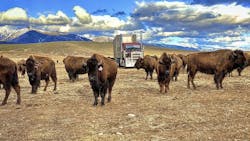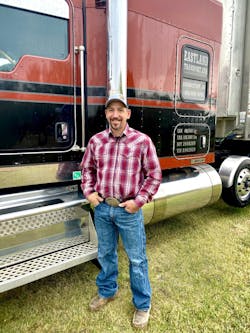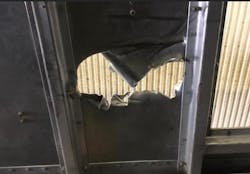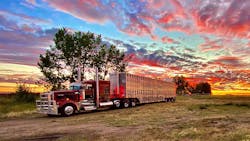The American bison was fittingly named the U.S. national mammal in 2016. Its size, power and mercurial potential for both gentleness and aggression all represent what the nation stands for. The way they were hunted to near extinction, as well as how they have been brought back from the brink, also tell a lot about the nation’s history. The population went from 30 million when Europeans found the continent to about 1,000 when the West was tamed around 1900.
That number is back up to 400,000, according to the National Bison Association, with 90% on North American ranches to support a $350 million/year bison meat industry. The effort to sustain the population’s growth requires genetic diversity, which in turn necessitates the relocation of bison throughout the year.
Hauling these bison is no easy task, but it’s become the life’s work for Tim Omilusik. The 41-year-old Canadian from Coronation, Alberta, runs a long haul livestock moving business called Eastland Transport and shares his bison-moving adventures on Twitter with the handle @eastland09. FleetOwner just had to know what it takes to do this job and has found out it’s one of the most dangerous and rewarding trucking jobs out there.
FleetOwner: Why did you get into trucking?
Tim Omilusik: After high school, I wanted to be a cowboy and started working on a feed lot close to home. They had their own truck and trailer, and they needed an extra driver, so I got my commercial driver’s license in 1998 and started driving an old 1980s Ford LTL 9000 and pulling a Wilson 50-ft. tandem. I did that for a couple of years. There was a commercial cattle hauler back home in Alberta. He had three trucks and I started working for him. and it took off from there. I just loved it. I got my first truck in 2009 and pulled as a lease operator until I got my own in 2010. I hauled cattle for quite a few years and hauled bison in between.
FO: And what's your current truck-trailer set up?
TO: A 2013 Kenworth W900L. I ordered it brand new September of 2012. It was my first truck with a DPF [diesel particulate filter] on it. It took a little bit to get used to. It is equipped with a Cummins 550 ISX/1850 torque. I’ve had Cummins all my life and was pretty impressed with the performance of the new emission engine. I have got just under 950,000 miles on it.
I’ve spec’d out a new truck, but with the way the economy is and the new prices, it’s pretty scary to jump into a new one. A truck I spec’d a little while ago came in at $265,000 Canadian. That’s just a lot of money.
I have a 2017 Merrick quad-axle trailer—built a little bit heavier than just your typical regular livestock trailer. It's still pretty weak when it comes to hauling bison. One time when I was hauling herd bison weighing just under 3,000 lbs., one of the big bulls didn’t like me on the roof and tore a hole through it trying to get at me. He ripped right through the roof like it was a tin can.
FO: How’d you learn how to haul bison?
TO: It's nothing that was really taught to me at all. You learn by doing, and you learn something new every day when you’re working with bison. It’s a job that takes focus and patience. You always have to be alert and ready for anything.
FO: What’s a day hauling bison entail?
TO: Lots of prep work. I’ll get up, do my precheck, and get myself psyched up for the day. Hauling bison is no easy task. It's a lot different than just hauling regular cattle. They’re quite a bit bigger and more aggressive and can cause quite a bit of damage to you, themselves and each other. You need to be calm and cool about it. Relax and have a plan in your head if something goes wrong.
These runs could be short or long. I’ve hauled bison up to 2,000 miles on one trip. It can be a pretty stressful ordeal.
I’ve also brought yak from the U.S. over the years. I had to quarantine them on the trailer for three days. They’re smaller, but a little more intimidating because their horns are so much longer.
FO: What are these bison for?
TO: I’ll haul slaughter bison or fats used for meat, most of which are to packing plants in Canada or the U.S. I haul feeder bison to feedlots and breeding stock all over as well. I have done some stuff for the Canadian government that was for scientific research, such as tuberculosis testing in bison.
It’s awesome to see bison walking the land again.
FO: Bison can weigh more than a ton; they are as big as a small car. And, as you said, they are aggressive. What makes you want to work with these giant beasts?
TO: I just love their nature. Their strength. Bison move at full strength all the time. You really have to be on your game. It’s 40 mph coming on to the trailer and 40 mph coming off it when they want to. It’s not something somebody can do alone. It takes a good group of people who know what they’re doing.
Bison have their own mindset. If they don't want to go, they're not going to go. You can't really force them. And keeping these animals’ stress level at a minimum is better for the bison.
I’d move them 365 days a year if I could, but it’s seasonal work.
FO: What’s your average load composition, and how long does a bison delivery take?
TO: One load will be 55,000 to 60,000 lbs. You can get about 100 feeder calves on board or 45 to 50 fats at 1,200 lbs. each. Most runs usually take a few days to complete. If I load in Canada, it’s a day to the border and then another one or two to the destination. Some compartments are smaller than others on the trailer, so you have to watch where you place them. You could really run out of room before you can get them all on.
USDA law mandates the time the animals can be on the trailer is 28 hours on trailer before they have to be unloaded for feed and water.
If they're going to be on the trailer for a long time, then I will have hay bales for feed and water tubs on the trailer. I carry a 100-ft. garden hose and will find a fuel station with a hydrant and put the hose through the trailer. It's a more challenging process and a little more time consuming, but it’s all for the welfare of the animals.
FO: So because of FMCSA rules, you have to sleep during that 28-hour span. You’re actually able to sleep with those animals right behind you?
TO: You can sleep, but it all depends on their mood. Sometimes they are good; other times they will thrash around the whole time.
The FMCSA rules are pretty difficult when it comes to any kind of livestock. It’s not like cattle. I can’t just stop anywhere and hope for the best. It doesn’t work that way. You’re risking the animals’ welfare. The regulations and rules make things tough, so I really have to plan proactively and keep my options open. You never know what’s going to happen.
FO: And you have to clean that trailer up after?
TO: Yeah, cleaning the trailer after every load is essential for bio-security and to keep the spread of disease down. It can be pretty overwhelming. During shedding season, you have more hair in the trailer than wood shavings or straw. I’ll find a place to shovel out everything and then find a washout to finish the cleaning. There’s usually so much hair it plugs up their system. I have been kicked out of more places than I can count.
FO: Because these are such large animals and they tend to move around, that must unbalance the trailer. How does that feel on the road and your control of the truck?
TO: You definitely feel the movement with the larger ones. Most of the time they are pretty calm. It’s when you get stopped, there can be trouble. For instance, one night I stopped just north of the U.S. for a morning border crossing. I had a lot of bulls on, and they started fighting in the trailer. I was up all night keeping an eye on all the bison so they wouldn’t tear my trailer apart.
FO: Has them running off ever been a concern?
TO: I had a close call a few years ago at a rest area in Montana. I was coming outside of the restroom and I caught a couple of animal rights activists trying to open the liftgate on my trailer and release the bison. They figured what I was doing was cruel and they should be set free to roam.
After a heated argument, they got into their car and drove away. Now I padlock every door and gate to keep that from happening.
Somebody could have seriously been injured or even killed. They had no idea what they were dealing with or the situation they were putting themselves and others in.
About the Author
John Hitch
Editor
John Hitch is the editor-in-chief of Fleet Maintenance, providing maintenance management and technicians with the the latest information on the tools and strategies to keep their fleets' commercial vehicles moving. He is based out of Cleveland, Ohio, and was previously senior editor for FleetOwner. He previously wrote about manufacturing and advanced technology for IndustryWeek and New Equipment Digest.




